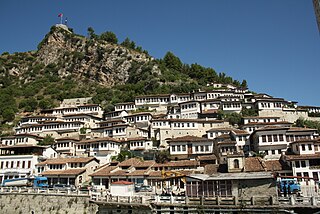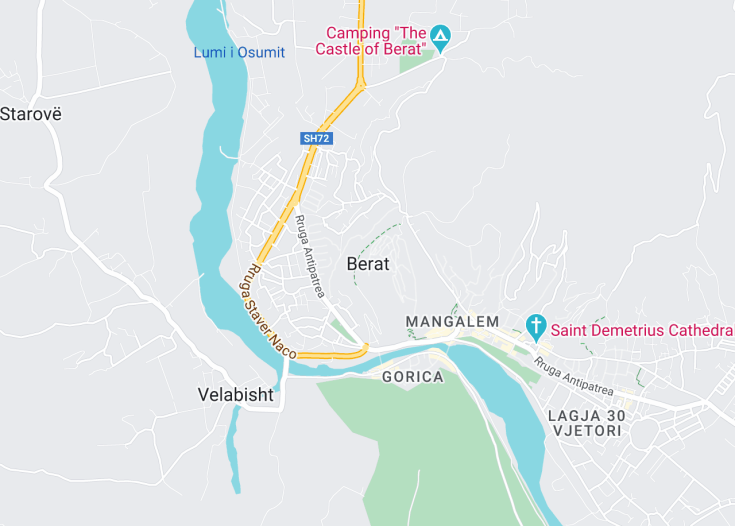Berat, a city in central Albania, is known for its rich history and stunning architecture, earning it the title of a UNESCO World Heritage Site. Its well-preserved Ottoman-era houses climb up the side of the hill, overlooking the Osum River, which adds a picturesque quality to the city’s layout. Berat is often referred to as the “City of a Thousand Windows” due to the unique facade of its buildings. This destination offers a unique peek into the historical lifestyle of the Albanians along with a robust cultural experience shaped through centuries of various influences.
For the best experience, visit Berat during the late spring or early autumn, when the weather is mild and the tourist crowds are smaller.
Consider exploring the city’s castle, known locally as Kala, which not only offers historical insights but also panoramic views of the Berat landscape.
Top things to do & see in Berat
Select the following sights and activities to discover best tickets and tours available in Berat.
Berat: The City of a Thousand Windows
| Country | Albania |
| Time in Berat | GMT+1 |
| Language spoken | Albanian |
| Population | 60,031 (INSTAT, 2021) |
| Currency | Albanian Lek (L, ALL) |
| Airports |
|
Berat is a gem in the heart of Albania that boasts a rich history dating back to the ancient Greeks and Romans. Known as the ‘City of a Thousand Windows’, its unique Ottoman architecture captures the essence of the region’s history. Berat is arranged upon a hill and is famous for its white ottoman houses that seem to stack upon one another, each adorned with large windows that overlook the beautiful Osum River. The city’s layout is a testament to various cultural influences and architectural styles from Byzantine churches to mosques and examples of medieval Balkan architecture.
Berat’s most notable landmarks include the Berat Castle, which dates back to the 4th century BC and offers panoramic views of the surrounding areas, and the UNESCO-protected neighborhoods of Mangalemi and Gorica. Inside the castle’s ancient walls, visitors can explore orthodox churches and several mosques, giving an insight into the religious harmony prevalent in the area. Besides its historical significance, Berat is also a hub for culinary enthusiasts, offering traditional Albanian cuisine that highlights the agricultural bounty of the region.
The city not only serves as a living museum of cultural heritage but also as a center for contemporary arts with several galleries showcasing local and international artworks. Its enduring appeal is complemented by various festivals throughout the year, including the National Folklore Festival and other cultural celebrations that draw in crowds from all over the world.
Where is Berat?
Located in central Albania, Berat rests on the banks of the Osum River, nestled between mountain ranges that elevate its scenic splendor.
Distances:
| Route | Distance by car | Time by car |
|---|---|---|
| Tirana to Berat | 72 miles | 2 hours |
| Durrës to Berat | 81 miles | 2.5 hours |
| Vlorë to Berat | 62 miles | 1.5 hours |
What is Berat famous for?
Berat is renowned for its distinct architecture characterized by whitewashed buildings with large windows, earning it the nickname the ‘City of a Thousand Windows’. This architectural style reflects the area’s historical depth and cultural diversity.
History
Prehistory to the Roman Era
The region of what is now Berat, Albania, showcases traces of human habitation that date back to the late Stone Age. Archeological findings provide evidence of settlements from the Bronze Age, growing progressively through the Iron Age into an area of strategic and commercial significance. Berat’s true establishment as an urban center, however, came under the influence of the ancient Roman Empire, which helped in developing its infrastructure and economy.
The Byzantine and Medieval Period
Following the split of the Roman Empire, Berat became a part of the Byzantine Empire. During this period, the city was fortified extensively, with the construction of massive walls and towers, parts of which still stand today. Berat gained religious significance with the construction of many churches during the 5th to the 13th centuries. The city also faced many invasions during these times, including those by the Slavic tribes and later by the Bulgarians.
Ottoman Rule (1417-1912)
During the Ottoman Empire’s rule, Berat played a vital role due to its strategic location. The city was transformed with the introduction of Islamic culture and architecture. Many mosques and buildings featuring traditional Ottoman architecture were constructed during this time. Berat became a center of art and culture, particularly known for its school of painters and the development of the unique tiered window design of its Ottoman houses, contributing significantly to its nickname as the “City of a Thousand Windows.”
Modern Era Post-Independence
Post the fall of the Ottoman Empire, Berat became an important center in the newly independent Albanian state. In the 20th century, despite the challenges posed by the World Wars and the Communist dictatorship, Berat preserved much of its historical heritage, which is now a significant part of its appeal. The end of the communist regime opened Berat to the world, leading to its recognition as a UNESCO World Heritage site, crediting both its historical architecture and the preservation of traditional crafts and folk art.
Visit Berat
What to see and do in Berat
Visitors to Berat, Albania, can delve into a rich tapestry of history and culture. Key attractions include the Berat Castle, which dates back to the 4th century BC and houses a collection of Byzantine churches and Ottoman mosques. The surrounding fortress area offers panoramic views of the Osum River and the historical district. The Iconographic Museum, located in the Onufri Museum within the castle’s grounds, displays exquisite icons and artifacts that highlight Albanian religious art through centuries.
Explore the Gorica Quarter and Mangalem Quarter, where the architecture of homes with their famous tiered windows offers an insight into Berat’s Ottoman past. For a taste of local life, visit the King Mosque and the Lead Mosque, both exemplary of Islamic architecture.
Outdoor enthusiasts can venture into the nearby Tomorr Mountain National Park, making Berat an excellent base for hiking and nature trips.
Annual Festivals and Events
Berat hosts several cultural events and festivals through the year that celebrate its rich history and vibrant community life. Notable events include the National Folklore Festival held every five years, gathering artists and performers from across Albania. The Berat Multicultural Festival, celebrated in summer, showcases music, dance, and workshops that emphasize cultural diversity. Additionally, the city marks traditional religious festivities with much fanfare, drawing both local and international visitors.
Best time to visit Berat
The best time to visit Berat is during spring (April to June) and autumn (September to November). These seasons offer mild weather, making it easier to explore the city and the surrounding nature. The landscapes are particularly vibrant in spring with blooming flowers, while autumn frames the city in warm golden hues, perfect for photography and leisurely walks.
Is Berat worth visiting?
Berat is undoubtedly worth visiting for anyone interested in exploring rich historical landscapes embedded with a plethora of cultural treasures. The city offers a unique glimpse into various epochs from the Roman times through to the Ottoman Empire and into modern-day Albania. UNESCO’s acknowledgment of Berat as a World Heritage site underscores its global cultural significance. Furthermore, the city’s architecture, with its distinctive windows and beautifully preserved neighborhoods like Mangalem, provides a picturesque backdrop that captivates every visitor.










